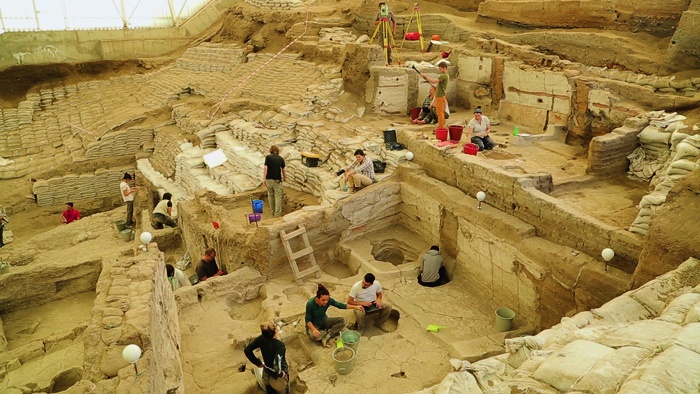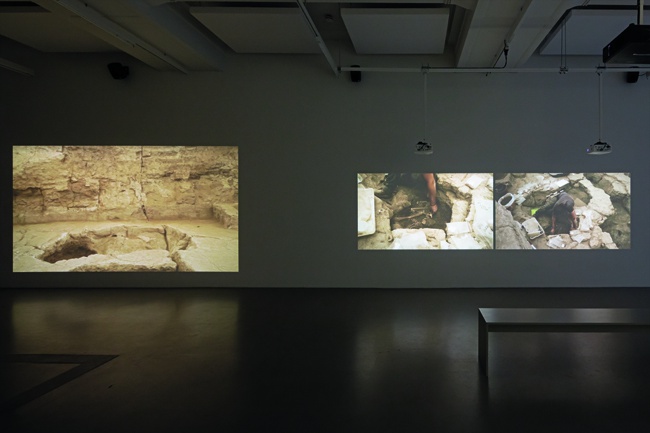Civilizational Entanglements Rike Frank on Rossella Biscotti at the daadgalerie, Berlin

Rossella Biscotti, „The City“, 2019, Filmstill
“The City” opens with a typical scene of an archeological dig: close-ups of numbered plates marking findspots on a sandy surface, people bent over excavations. The scraping and scratching of tools and voices resonate from offscreen. Before conversations about the found objects become comprehensible, the soundtrack of the work draws attention to the multi-accented English-speaking voices, allowing us to infer the constellation of an international (work) community. Conversations proceed from explanations of the sequences of uncovered building structures and the astonishing amount of resulting material on the assumption that the houses collapsed due to instability and offerings were left behind intentionally, toward theories about the social structures among the former inhabitants of the collapsed edifice: “The notion of house society originally is about a community that shares an investment in a property,” explains a female voice. “It’s not about biologically related people. If you think about it from the perspective of all the people who have an investment in the continuity and reproduction of the house, in this sense, that investment is the proof that you belong […] Your identity with that space is dependent on your investment, fundamentally, of labor. So for me that particular datum is […] entirely predictable if what we talk about is the notion of a house society at its very essence, which is collaborative work […]”
Çatalhöyük, the name of this excavation site, in present-day Turkey, is one of the earliest Neolithic settlements, once home to thousands of people some 9,000 years ago. For a Neolithic society, Çatalhöyük is a paragon of the “civilizing” transition from nomadic to sedentary life. At the same time, it is also in its present state a research site that deploys a critical, reflective approach, coined by Ian Hodder, professor of anthropology at Stanford University and leader of the Çatalhöyük excavations since 1993, whose concepts of diachronic entanglement and multi-temporality have opened up the academic discipline of archaeology. In Hodder’s publications – such as Spatial Analysis in Archaeology (1976), Reading the Past (1986), and Entangled: An Archaeology of the Relationships between Humans and Things (2012) – he has traced a genealogy of debates in the field of archaeology that parallels similar developments in contemporary art and art criticism.

„Rossella Biscotti: The City“, daadgalerie, Berlin, 2019, Ausstellungsansicht
Rossella Biscotti’s own engagement with the stratified nature of the location began with her visit to the Museum of Anatolian Civilizations in Ankara in the summer of 2013. The curators Övül Durmusoğlu and Mari Spirito, founder of Protocinema who comissioned "The City", had approached the artist together with Akram Zaatari for the research project Asar-ı Atika/Ancient Works, which emerged from an Independent Curators International Open Call sponsored by the SAHA Association, calling on alumni to develop a curatorial project in Turkey. Since both curators had taken part in the ICI Curatorial Intensive at the Instituto Inhotím in Minas Gerais, Brazil, dealing among other things with site-specific projects within extended museum concepts, the plan for the research process was to further pursue and explore the idea of the encounter. After discussions – including with the museum’s directors – about the origin of the objects, the way they would be displayed, and the narratives embedded in them, there arose a desire to visit the excavation sites themselves. Particular attention was paid to Çayyolu Höyüğü and the Phrygian City of Gordion (near Yassihöyük) due to their geographical proximity both to Ankara and to the Neolithic settlement of Çatalhöyük. For the presentation of this first research trip via three dialogues in Ankara, Istanbul, and New York, Zaatari chose the film “The Night of Counting the Years” (Egypt, 1969) by Shadi Abdel Salam, with Biscotti choosing “Journey to Italy” by Roberto Rossellini (Italy, 1954).
Biscotti contacted Ian Hodder for the first time in the hope of gradually pushing the process forward, finally spending a period of six weeks during 2015 on site as a member of the archaeological team. The first recordings date from this period and form the beginning of the five-channel video installation, originally intended as notes in preparation for a documentary film about the coexistence of the archaeological and Neolithic communities, and the space in-between them, which frames this location like a bracket. In this respect, the list of names that is attached next to the entrance of the daadgalerie like a pre-placed index of credits is more than a gesture of recognition: the list visualizes the international community described above, which, like its Neolithic predecessors, temporarily comes together and defines its togetherness through shared efforts and collaborative work, to pick up the offscreen commentary discussed at the outset.
Using the concept and figure of community, Biscotti interweaves the research narrative, conditions of production, and aesthetic forms for her video installation. The relationship between the five projections of different sizes is thus defined by the question of what connections we make between different pieces of information, how we assemble and combine them. What are the correlations between material and population, bodies and infrastructures, numbers and tools, recordings of individuals and groups?
Interestingly, the artist shifted the complexity of these processes of connection, and the resulting formation of hypotheses and theories, not into the camera work or montage, but into the audio component of the work: this spatialized, topological sound symbolically deploys the idea of the digital matrix into which, as demonstrated in “The City,” all individual parts found in the excavation site are registered and transferred for off-site use. The work on Çatalhöyük’s matrix is only briefly visually depicted, then deliberately withheld from view, undermining any institutionalizing links between archaeology and its linear, reconstructive replicas. On the level of the soundtrack, this has the effect of directly translating aspects of Hodder’s approach (such as diachrony) into artistic practice. Hodder’s theory of how our entanglements with material things draw us onto certain evolutionary and historical paths, while also limiting the range of decisions that could potentially be made, is concretized by the protagonists’ offscreen dialogue: speculating on the identity and purpose of what they are seeing, while also articulating their doubts, amazement, knowledge, and ignorance, ultimately demonstrating how a like-minded community nevertheless contains highly diverse expertise.
About halfway through the 45-minute installation, the atmosphere changes abruptly: silence sets in, with two projection screens showing an excavation site emptied of objects and people as the other channels go black. In 2016, Biscotti was returning with a camera team to Çatalhöyük when, as a result of the failed military coup on the night of July 15–16, 2016, a crisis meeting led to the announcement of the immediate closure of the excavation site, as the safety of the teams working there could no longer be guaranteed. As can be heard from offscreen after two minutes, 75–80 percent of the Çatalhöyük team were gone within a week. The subsequent instructions on how to organize this process of withdrawal once again illustrate the various dimensions of the project, the size of the international community, and the volume of materials and work tasks; however, they also highlight the consequences for the individual research projects that at that time, three years before the official completion of the project, had to be abruptly terminated so that the group could join together to protect, record, and stow away the findings from the site, preparing for any possible future continuation of the work. As in the first section of the video, “The City” traces work processes, but the effects of the retreat are present both in the reduction of conversations to data and coded series of numbers, and in the sandbags set up to protect the excavation sites. The artist decided to document the evacuation and stay until the very end, when first the international community, and then the Turkish workers, had left the area. The final images show parts of a landscape, while a man and a woman, in radio dialogue, try to identify a specific place in the distance: “Is it here?” “Yes it is.” “Or here?”
Returning to the idea of producing a documentary film, Biscotti is currently working on a new, single-channel version. In addition, Çatalhöyük’s project page is still available online; in the Research Portal sub-section, number combinations recalling the film’s soundtrack can be found: “Area GDN has 12 Buildings identified so far.”
“Rossella Biscotti: The City,” daadgalerie, Berlin, January 19–March 13, 2019.
